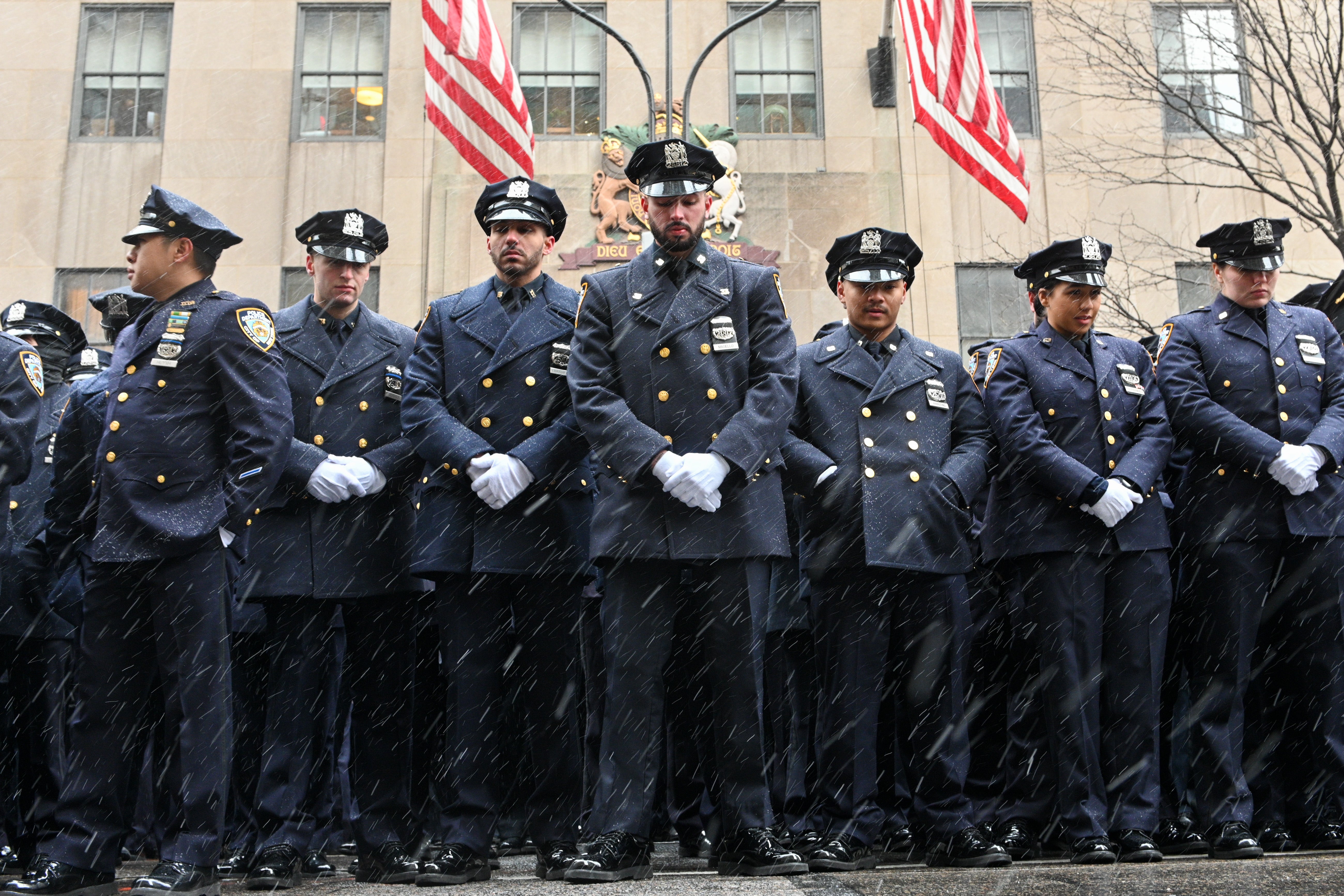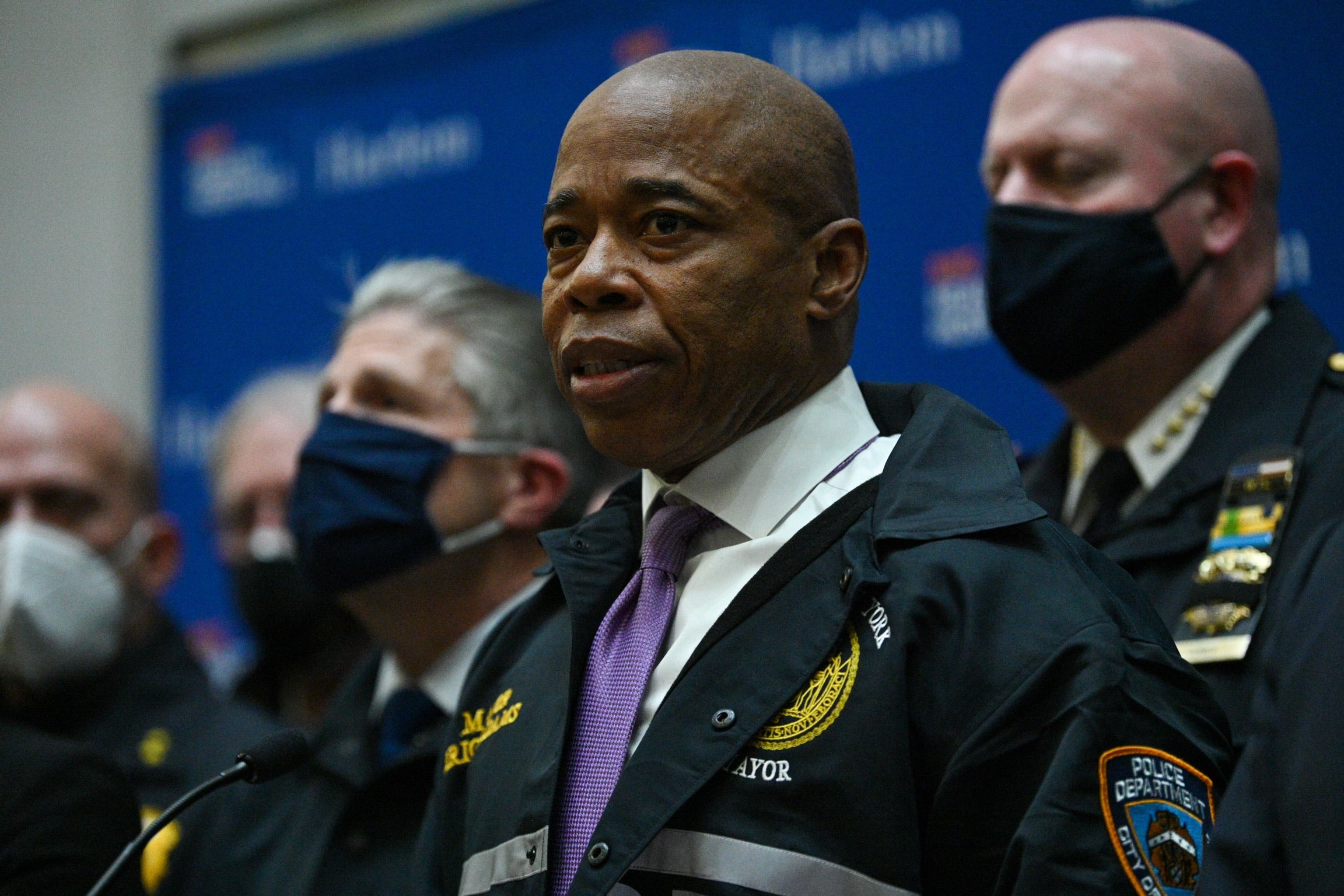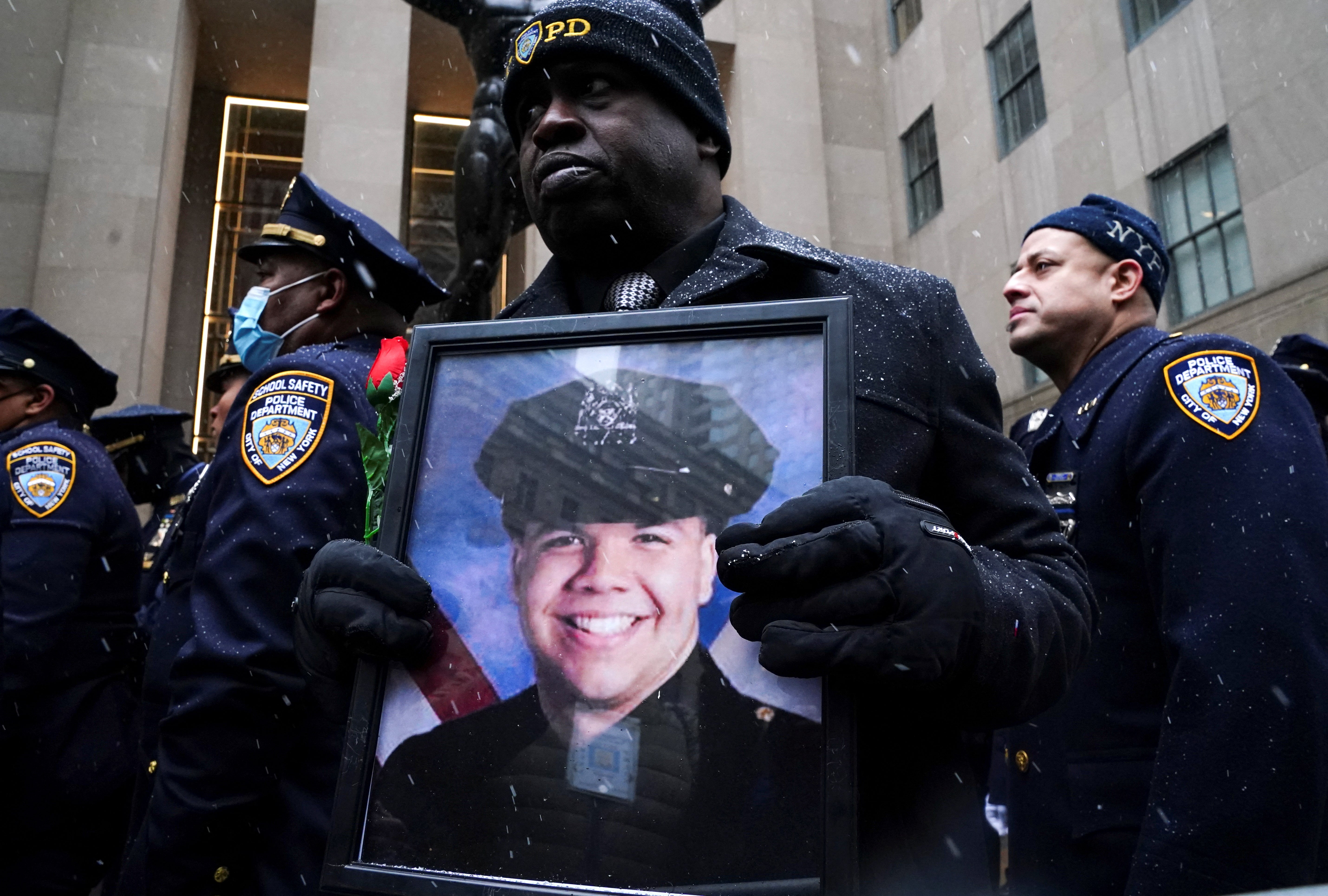What’s behind a spike in police shootings? High-profile violence revives calls for reform – and familiar scapegoats
Following a deadly year for law enforcement, competing narratives about what’s behind the violence have obscured root causes, Alex Woodward reports


In the first month of 2022, at least 24 law enforcement officers in the US were shot, including three officers killed while on duty, and an off-duty officer who was fatally shot during an attempted robbery, according to the Gun Violence Archive.
Last year also marked one of the deadliest years for US law enforcement in modern history. For the second year in a row, the leading cause of death among law enforcement officers was Covid-19, which killed 301 officers in 2021, according to the National Law Enforcement Officers Memorial and Museum.
Sixty-two officers were killed by gunfire.
A rapid succession of headline-grabbing tragedies, and futile attempts to explain them, have obscured discussions about violence prevention and tackling root causes while resurrecting familiar boogeymen.
Police unions and law enforcement groups have characterised recent shootings as a byproduct of a crime wave, and politicians and other officials have invoked recent high-profile shootings to denounce “defund” movements and racial justice protests while suggesting that advocacy groups and progressive legislators failed to come up with solutions.
Criminal justice advocates have condemned what they see as law enforcement’s competing narrative about public safety, one that exploits tragic headlines to drum up support for policies that lead to the same discriminatory outcomes they fought in the first place.
Experts contend that there is no evidence that recent trends in violent crime are linked to any single factor but are more likely a “perfect storm” of circumstances, including impacts from the Covid-19 pandemic, from its economic fallout and societal failures to how law enforcement agencies are able to function. The upending of “normal” American life also is running parallel to declining trust in police and more mainstream attention towards progressive reform efforts.
There is also no evidence that declining confidence in law enforcement or efforts among criminal justice advocates have contributed to a rise in shootings against police.
Some reports suggest that a somewhat opposite effect has contributed to spikes in shootings: police disengaging from the communities they serve.
A 2020 report from the Giffords Law Center to Prevent Gun Violence republished in 2021 details how a “dangerous, downward spiral of disengagement” among law enforcement – compounded by legacies of inequality, racism and poverty – “ultimately leads to spikes in violence and vigilantism that threaten the safety of residents and officers alike.”
An uptick in violence also follows another year in which more than 1,000 people in the US were killed by police. More people were killed by police in the US last year than in almost any year within the last decade.
Police killed 1,134 people in the US in 2021, when there were 15 days in which a police officer did not kill someone in the US, according to Mapping Police Violence.
Roughly one-third of incidents included an alleged violent crime, while 57 per cent involved traffic stops, police responses to mental health crises, or situations where the person was not reportedly threatening anyone with a gun, according to the organisation.
Maria Haberfeld, a professor of police science at John Jay College of Criminal Justice in New York City, believes “anti-police sentiment” across social and traditional media and among legislators and public officials has created an environment in which police officers believe they are in danger.
She suggested politicians have failed to address root causes of crime and draft laws that would allow police departments to adequately deploy their resources, resulting in the “scapegoating of an entire profession,” she told The Independent.
“Who wants to become a police officer today?” she said. “We’re going to have worse and worse police forces.”

But a familiar scapegoat has emerged: Bail reform, and efforts to prevent jails from holding defendants awaiting trial before they have been convicted of a crime, solely because they cannot afford to pay to get out.
Bail reform advocates argue that current bail systems disproportionately impact minorities and low-income defendants who are more likely to be stuck in jail awaiting trial, while wealthier people can buy their way out of pretrial detention.
Conservative legislators and police groups argue that new measures allow sometimes dangerous criminals back on the streets, pointing to reports of suspects released from jail who go on to commit other crimes.
“There is no link between bail reform and the shootings, and there’s no link between the increase in gun violence and bail reform, but it’s an opportunity for law enforcement and some prosecutors to scale back what New York achieved,” according to Yung Mi Lee, legal director in the criminal defense practice at Brooklyn Defender Services.
New York state legislators passed bail reform in 2019, mandating pretrial release for a majority of nonviolent charges and requiring that judges consider a person’s ability to pay bail. Judges never lost discretion to set bail or detention in most violent felony cases.
“For violent felony arrests, judges still retain an enormous amount of discretion,” Ms Lee told The Independent.
Between July 2020 and June 2021, defendants released without bail pending trial were rearrested for a violent felony in 2 per cent of cases, with less than half of one per cent of rearrests involving a firearm, according to state data. An overwhelming majority of defendants did not have any law enforcement issues after their release before trial.
“Instead there are thousands of people – mostly Black, brown, and low income – who are simply able to be at home with their families, take their kids to school, keep their housing and jobs while they await their day in court,” New York State Director of Criminal Justice Reform at FWD.us Rodney Holcombe told New York’s PIX11. “It’s important we follow the facts here … and get to the root of violence and crime.”
Spikes in violent crime are not limited to cities where bail reform efforts have been implemented. Out of the 66 largest police jurisdictions in the US, 63 saw an increase in at least one category of violent crimes in 2020, according to the Major Cities Chiefs Association.
New York Assembly Speaker Carl Heastie told reporters earlier this month that the state’s bail reform has become a “scapegoat” for rising crime and gun violence in US cities.
“Part of my frustration is that when anything bad happens, it’s got to be bail reform’s fault,” he said. “There’s a whole lot of things going on, and it’s so easy to scapegoat it onto bail.”
On 18 January, a New York City Police Department officer tackled a 16 year old in The Bronx, and the gun the teenager was carrying accidentally discharged, sending a bullet through his leg before grazing the officers’ thigh.
He was charged with assaulting an officer and possession of a loaded firearm. His bail was set at $200,000 cash, a $250,000 insurance bond or a $250,000 partially secured bond. He was released after a family paid $17,500 to secure the bond.
His release came on the heels of the fatal shootings of two NYPD officers responding to a domestic disturbance call in Harlem on 21 January.
After speaking at a funeral for one of the officers, New York City Mayor Eric Adams slammed the state’s bail reform law, suggesting that the teenager arrested in The Bronx – who was not involved in the Harlem shootings – is “walking free on bond because judges are precluded from even considering danger to the community.”
“It is further proof that our current system is failing us,” he said in a statement on 28 January. “Today of all days, with the city in mourning over the deaths of Detective First-Grade Jason Rivera and Police Officer Wilbert Mora, we all must come together and agree that changes are needed. We cannot allow those who carry guns to walk free – we can pursue safety and justice at the same time, and we must, for the safety of all of us.”
In a statement to The New York Post, Police Benevolent Association president Patrick Lynch said “if anybody wants to know why we have a crisis of violence in this city, or why we’re about to bury two hero police officers, look no further than this disgraceful bail release.”
But the charges against the teenager were not affected by the state’s bail law. Prosecutors were not prohibited from asking that he remain behind bars before trial. The judge set his bail, and he was able to post bond.
When he was 14, the teenager was charged with criminal possession of a weapon. He was sentenced to six months probation in 2020, according to The New York Times. The gun was allegedly not loaded and was being used as a prop in a music video shoot.
The mayor’s office clarified that the mayor’s recent statement was criticising how the state prevents judges from considering so-called “dangerousness” when determining whether to remand someone and hold them without bail.
Judges using that discretion to determine a defendant’s “dangerousness,” or threat to public safety, could lead to the same disproportionate outcomes, according to Speaker Heastie.
“I think when you start putting back … judge’s personal opinions, personal thoughts, when they look at an entire situation someone may have, you start to come back to possibly having some uneasiness,” he told reporters this month.
If judges were able to use the dangerousness determination in setting bail, “we would have even greater racial disparities,” Ms Lee told The Independent.
Risk assessment mechanisms powered by arrest data are still likely to yield discriminatory outcomes if such algorithms rely on discriminatory policing, she said.
“Bail laws and the way bail was used to force guilty pleas and incarcerate people had a really long-lasting and damaging effect – not just on the person but in the community in general,” she said.
“You’re losing a father, a brother, and you get this destablisation,” she added. “There’s a lot of repair that needs to happen. But I think right now that many people are able to stay out of jail, come back to court … you’re already saving that individual’s life from all the collateral consequences that happen from incarceration, pleading guilty, having a record, not being able to get a student loan, not being able to get a job.”

In the wake of the fatal shootings of NYPD officers, Mayor Adams has brought his focus into another crisis: the proliferation of illegal guns.
Lashawn McNeil, the man who NYPD said fatally shot officers Jason Rivera and Wilbert Mora, was allegedly armed with a handgun that was reported stolen in Baltimore several years ago, and equipped with a high-capacity drum magazine capable of holding 40 rounds.
A majority of guns used in violent crimes in New York come from outside the state, according to a 2016 report from the state’s attorney general. Of those guns, 70 per cent come from the so-called “iron pipeline”: six southern states along the Interstate 95 corridor with less stringent gun laws than New York.
At a recent press conference, Mayor Adams said NYPD officers have taken 350 illegal guns off the street since the beginning of the year, and more than 6,000 in 2021.
“That must end. We must stop the flow of illegal guns into our city. The iron pipeline must be broken,” he said.
As part of his Blueprint to End Gun Violence, Mayor Adams is pledging to boost patrol units, open gun checkpoints and revive controversial plainclothes “anti-crime units” with a focus on seizing illegal guns.
“So they will be identifiable – not the way it was before when they were not identifiable at all. You don’t know who’s jumping out of the car at you, and that creates a lot of hostility,” he said.
Manhattan District Attorney Alvin Bragg is also pledging to aggressively prosecute gun-related crimes, after he said during his campaign that he would avoid prosecuting people for gun possession unless they were involved with a violent crime, and New York Governor Kathy Hochul is leading an Interstate Task Force on Illegal Guns, backed by a push from US Senator Chuck Schumer to get $1.5bn in federal funding.
President Joe Biden, who will meet with Mayor Adams to discuss gun violence on 3 February, pledged last year to go after “merchants of death” flooding the US with illegal guns, while congressional efforts for broader gun control measures at the federal level have languished.
In a recent editorial, the state’s Times Union newspaper wrote: “Strengthening gun control may not be a panacea for the gun violence that plagues our communities, but it would be a far more productive approach than waiting, shooting after shooting, for just the right one to match a tired political narrative.”



